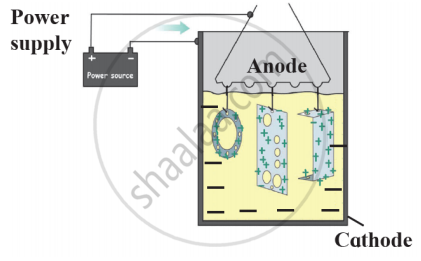Advertisements
Advertisements
Question
Write a short note on Alloying.
Solution
- The homogenous mixture formed by mixing metal with other metals or nonmetals in a certain proportion is called an alloy.
- Majority of the metallic substances used presently are in the form of alloys. The main intention behind this is to decrease the intensity of corrosion of metals.
- For example, bronze is an alloy formed from 90% copper and 10% tin. Bronze statues do not get affected by the sun and rain. Stainless steel does not get stains with air or water and also does not rust. It is an alloy made from 74% iron, 18% chromium and 8% carbon.
- In recent times various types of alloys are used for minting coins.
APPEARS IN
RELATED QUESTIONS
Give two examples of alloys with their chemical composition.
Which metals do not corrode easily?
Answer the following question.
What are alloys?
Give reasons:
Platinum, gold and silver are used to make jewellery.
Explain why rusting of iron objects is faster in coastal areas than in deserts.
Choose the correct answer from the options given below:
Heating an ore in a limited supply of air or in the absence of air at a temperature just below its melting point is known as
A. Smelting
B. Ore-dressing
C. Calcination
D. Bessemerisation
What is anodising? Give its applications.
What type of chemical reaction is involved in the corrosion of iron?
In one method of rust prevention, the iron is not coated with anything. Which is this method?
Fill in the following blank with suitable word:
The corrosion of copper produces a .............. coating of basic copper carbonate on its surface
Give the constituents and one use of brass.
Name two metals which resist corrosion due to the formation of a thin, hard and impervious layer of oxide on their surface.
Explain why, when a copper object remains in damp air for a considerable time, a green coating is formed on its surface. What is this process known as?
Explain why, the galvanised iron article is protected against rusting even if the zinc layer is broken.
Name a common metal which is highly resistant to corrosion.
A metal X which is resistant to corrosion is produced by the electrolysis of its molten oxide whereas another metal Y which is also resistant to corrosion is produced by the reduction of its oxide with carbon. Metal X can be used in powder form in thermite welding whereas metal Y is used in making cathodes of ordinary dry cells.
(a) Name the metals X and Y.
(b) Which of the two metals is more reactive : X or Y?
(c) Name one ore or metal X. Also write its chemical formula.
(d) Name one ore or metal Y. Also write its chemical formula.
(e) Name one alloy of metal X and one alloy of metal Y.
Four metals P, Q, R and S are all obtained by the reduction of their oxides with carbon. Metal P is used to form a thin layer over the sheets of metal S to prevent its corrosion. Metal Q is used for electroplating tiffin boxes made of metal S whereas metal R is used in making car batteries. Metals Q and R form an alloy called solder. What are metals P, Q, R and S? How have you arrived at this conclusion?
Mention two uses of the following metals and non-metals
Iron
Explain how the activity series accounts for each of the following:
tendency to corrosion
What is corrosion? What are necessary conditions for corrosion?
State whether the statement given below is true or false. If false write the correct statement.
Either oxygen or moisture is essential for rusting.
_______ forms a green colour in the water.
When one of the metals in an alloy is mercury the alloy is called _______.
Match the columns.
| Group A | Group B |
| 1) Electroplating | a) Pressure cooker |
| 2) Anodising | b) Silver plated spoons |
| c) Coating of tin on copper | |
| d) Coating of Zinc on iron |
Explain concept with example/explain with the help of a balanced equation.
Corrosion
Write a molecular formula for rust.
Observe the following diagram and give answers.

- Name this method of prevention of corrosion.
- For prevention of which metal this method is used?
- What is used as anode in this method?
Observe the following diagram and write answers.

- Name the method.
- Explain the method.
- Give two examples of this method.
What is rust?
Copper objects lose their shine and form green coating of ____________.
Marble’s popularity began in ancient Rome and Greece, where white and off-white marble were used to construct a variety of structures, from hand-held sculptures to massive pillars and buildings.

The substance not likely to contain CaCO3 is:
Identify the correct statement from the following:
Generally, when metals are treated with mineral acids, hydrogen gas is liberated but when metals (except Mn and Mg), treated with HNO3, hydrogen is not liberated, why?
A man painted his main gate made up of iron, to
- prevent it from rusting.
- protect it from the sun.
- make it look beautiful.
- make it dust-free.
Which of the above statement(s) is/are correct?
State whether the following statements are true or false:
Ships suffer a lot of damage though they are painted.
In ______ process a layer of molten tin is deposited on metals.
Describe two changes that are harmful. Explain why you consider them harmful. How can you prevent them?
